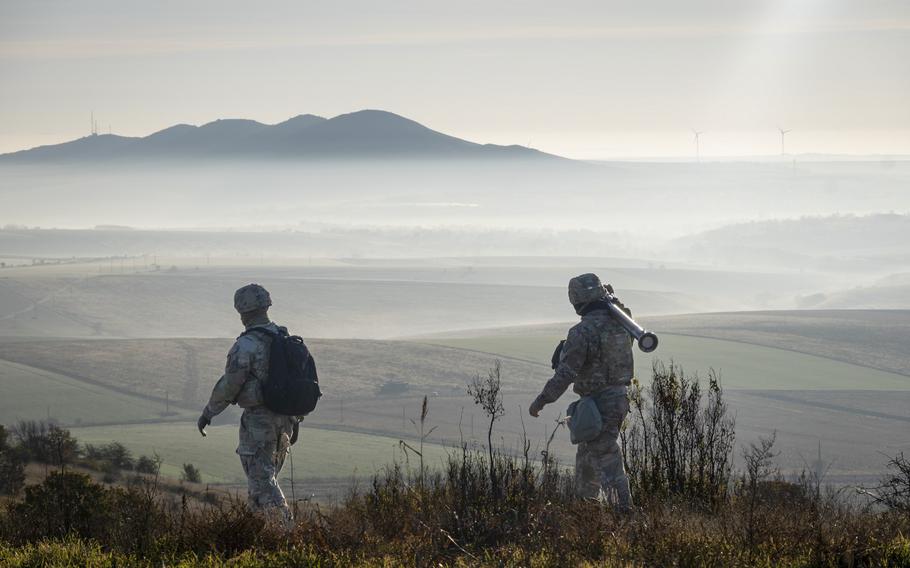
U.S. soldiers from 1st Platoon, Alpha Battery, 1-57 Air Defense Artillery Regiment train with a Man-portable Air Defense System during exercise Southern Shield in Romania on Nov. 19, 2024. (Leara Shumate/U.S. Army)
An American air defense platoon has been monitoring NATO’s eastern flank for more than a week from an undisclosed location in Romania, as part of an exercise that coincides with what Romanian officials say are ongoing drone incursions likely launched by Russia.
Parts of Romania near the border with Ukraine have seen persistent violations and some Romanian lawmakers are calling for the alliance, and potentially U.S. units, to start shooting the drones down.
Such decisions are well above the pay grade of the U.S. soldiers on the ground at the air defense site, who told Stars and Stripes in phone interviews that their work with Romania’s armed forces reflects U.S. commitment to NATO and its reassurance mission.
The Southern Shield exercise, scheduled to end Tuesday, also puts the capabilities on display of a platoon that was reactivated about a year ago in Germany, along with the rest of the 1st Battalion, 57th Air Defense Artillery Regiment.
Two platoons from the regiment’s Alpha Battery were quietly deployed eastward in the fall. The platoon known as the Juggernauts was sent to Romania, while the other was sent to Poland. Both took over existing rotational deployments.
Capt. Kurt Blumeyer, Alpha Battery’s commander, said the Juggernauts have exceeded expectations during the Romania exercise.
“Our NATO partners can see that within a year, we can rapidly stand up additional capabilities if it becomes necessary,” Blumeyer said. “These guys have demonstrated that.”
In Romania, the Juggernauts normally operate from the sprawling Mihail Kogalniceanu Air Base. But for the Southern Shield exercise, they relocated their Avenger systems on short notice.
Once there, they integrated their systems into the Romanians’ layered air defense network to deal with a mock short-range air defense threat.
“We are a chess piece that our battalion commander is able to utilize wherever he sees that we need to be used,” said Sgt. 1st Class Matthew Eickmeyer, the Juggernauts’ platoon sergeant.
Whether units like the Juggernauts could one day switch from deterrence to active defense is an open question. NATO has maintained that the suspected Russian violations lack clear hostile intent.
But critics say that doesn’t change the fact that the alliance’s airspace is being repeatedly compromised. And while the initial incidents reported involved only drone debris, they appear to be evolving into direct incursions into NATO airspace.
Last month, without mentioning Russia, Romania’s Defense Ministry said it had deployed two F-16 jets and two Spanish F-18s after a drone was detected inland in the southeastern county of Constanta, home to the Mihail Kogalniceanu base, where many U.S. and allied units operate.
Shortly afterward, Romanian lawmakers drafted government-backed legislation that would allow air defense units to shoot down drones that illegally breach the country’s airspace. Current domestic law prohibits destruction of aircraft flying over the country.
The bill stipulates that “allied systems present in Romania could also participate in any action, in agreement with collective defense treaties,” according to Reuters.
Romania’s defense minister also has joined his counterparts across the eastern flank in calling for a NATO-wide response to repeated violations of their airspace.
Ann Dailey, a policy researcher at Rand Corp., said that without such a response, not only could the incursions start resulting in significant damage or loss of life, but Russia could also exploit the inaction by purposely violating NATO airspace.
“Historically, Russia uses a sort of boil-the-frog approach to inuring NATO nations against some of their activities, and if they don’t experience pushback then they just keep dialing up the heat,” Dailey said in a phone interview. “So it is incredibly important that NATO responds to these incursions.”
Under international law, nations have sovereignty over their airspace. Shooting down a drone may not be considered an act of war but rather an act of enforcement — or in NATO’s case, collective self-defense.
However, shooting down airborne threats could pose danger to civilians and infrastructure in some cases. The weapons used by air defense systems also are much more expensive than the drones that have so far illegally entered Romanian airspace.
Most of the drones involved in the incursions fly very slowly and at low altitude, meaning they are more difficult to detect with traditional ground-based radars, especially radars conceived and developed to deal with missiles and fast objects flying into the air, said Federico Borsari, a resident fellow at the Center for European Policy Analysis.
Both Dailey and Borsari said NATO must develop new capabilities to deal with the airspace threats.
Units like the Army’s air defense artillery still can target a host of threats, including more destructive missiles. The American soldiers in Romania said their presence in the country and exercises like Southern Shield allow them to act quickly in the event of a flashpoint.
“What we are doing is setting the conditions that if needed, we already have the muscle memory to work with our allies for a common operating picture,” said Lt. Col. André Ruff, commander of the 1st Battalion, 57th Air Defense Artillery Regiment.
Juggernauts platoon leader 2nd Lt. Gabbi McElyea agreed.
“Our platoon likes to get out there and get into the field and train as best we can so we’re prepared for whatever comes our way,” McElyea said. “We’re out here becoming more combat-ready should that call come down to us.”